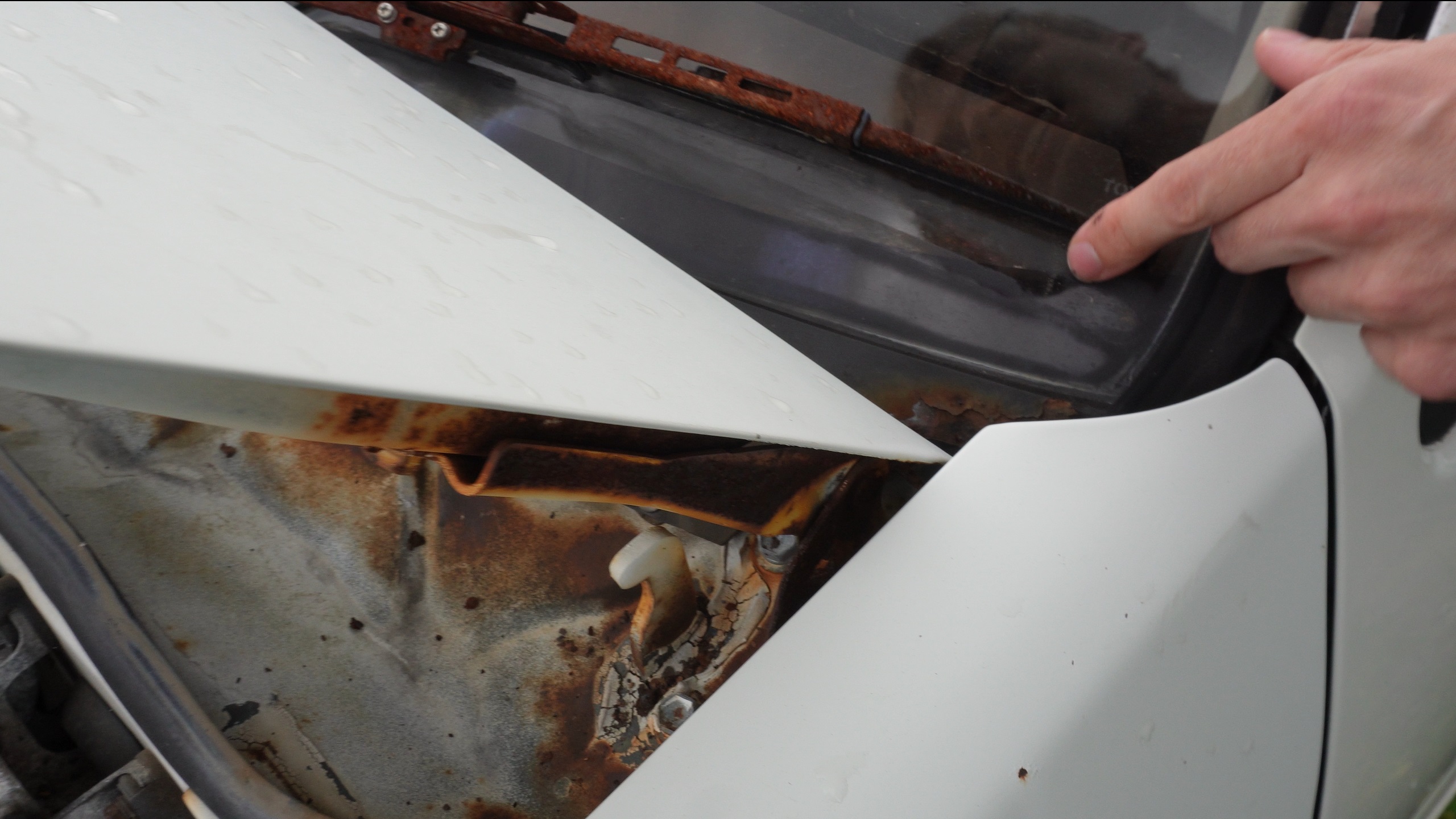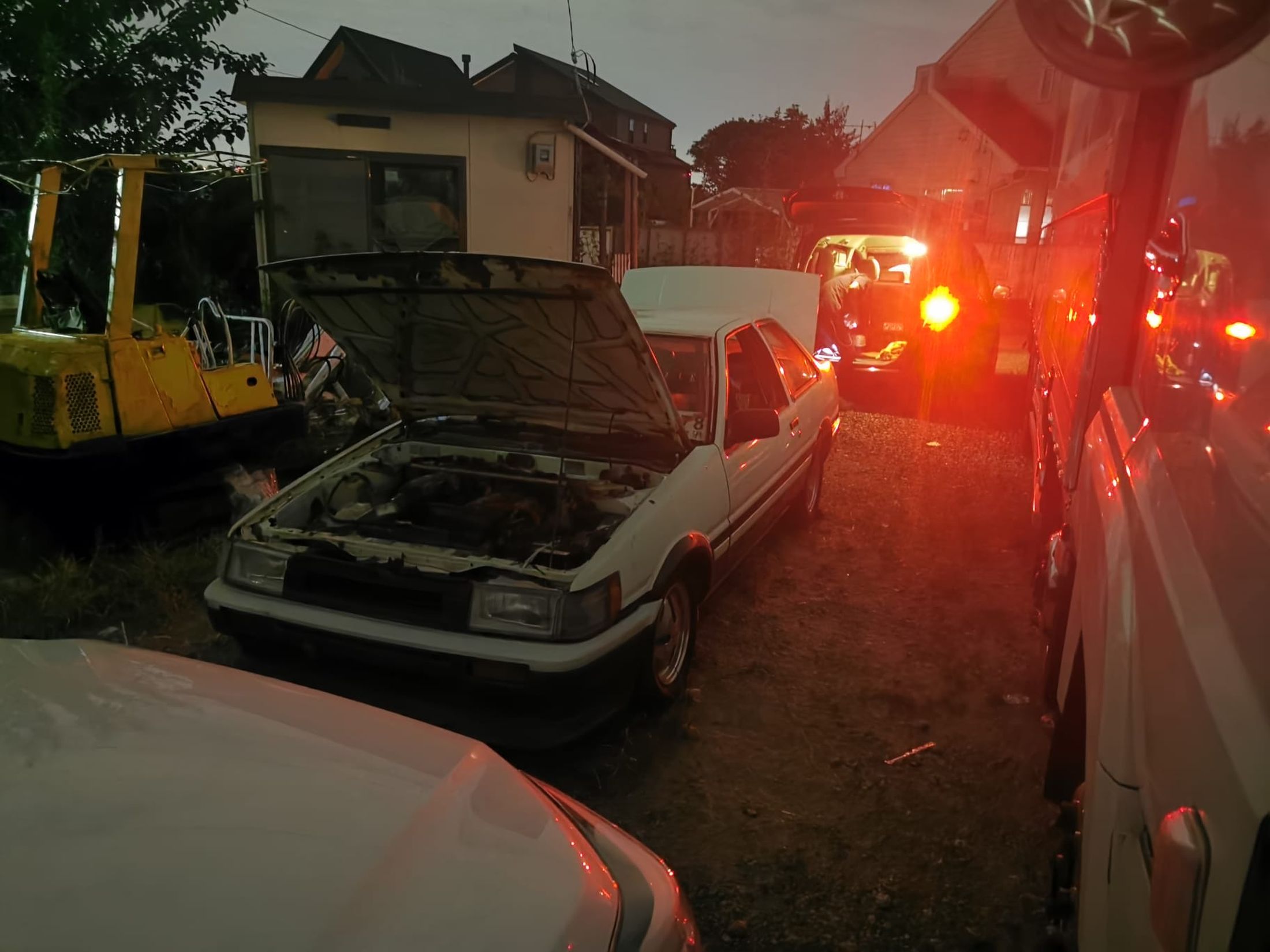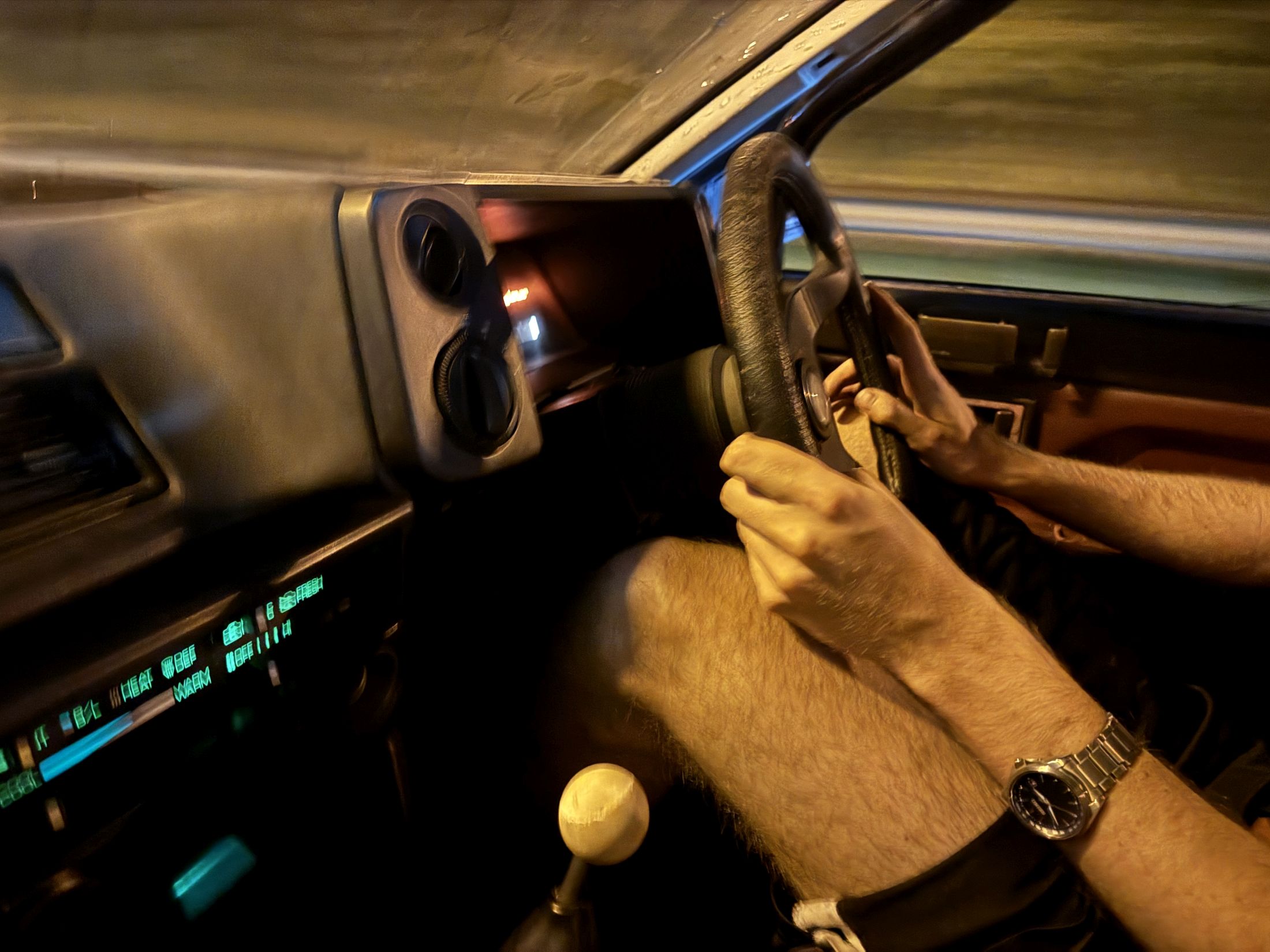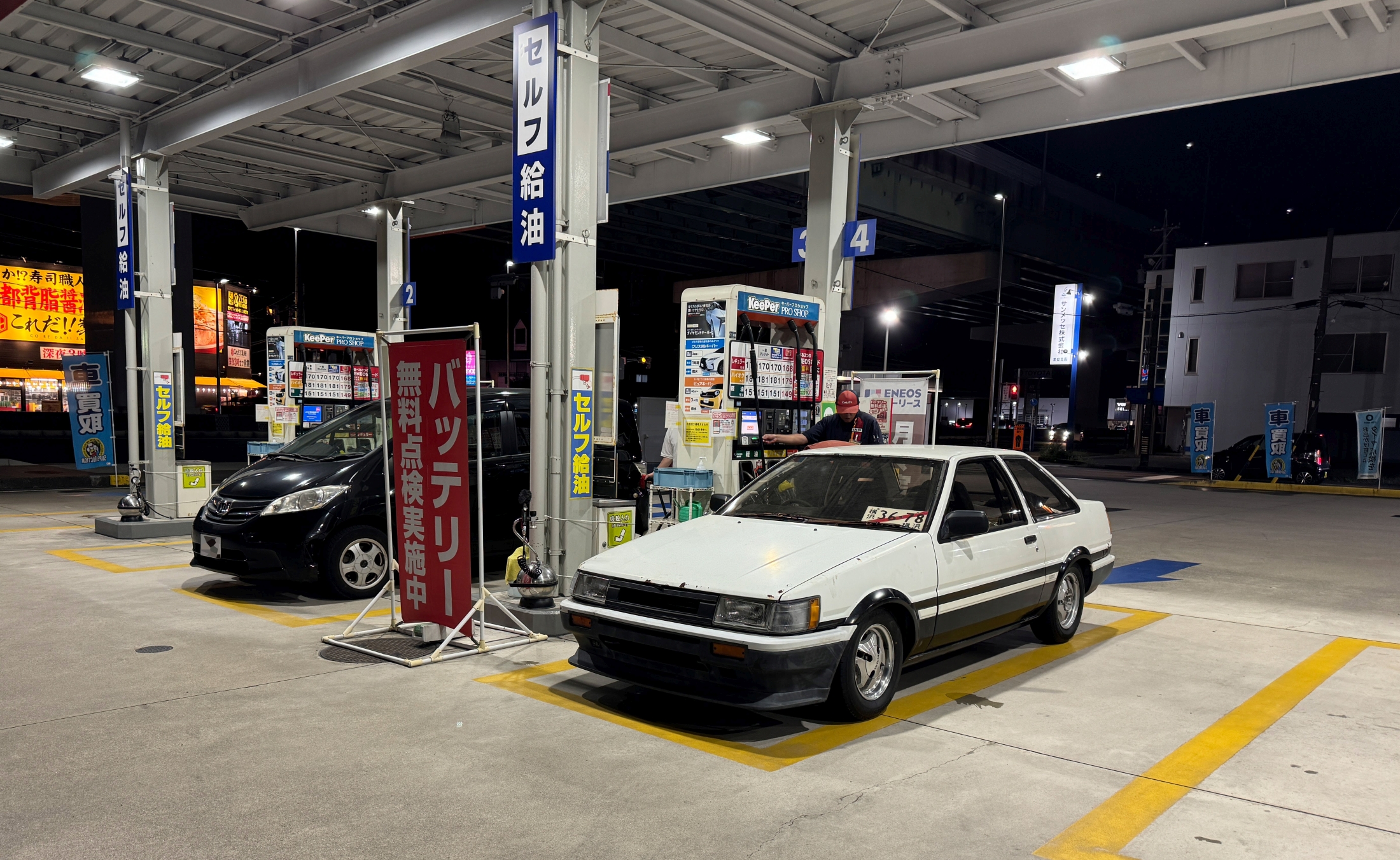I bought a rusty AE86 unseen of yahoo auctions. The car had been sitting for over eight years, has rust, faded paint, and an expired vehicle inspection. I plan to restore this car as my weekend car. My Japanese is not great, so buying and restoring an old car will be quite a challenge, and a fun learning experience. This is the story of reviving my white-over-black AE86 Levin GT-APEX!
In the first chapter, I described how I found this AE86 and how it happened to become the highest bidder on yahoo auctions. Together with a friend, we hatched a plan how to bring this car back home. We decided to drive to the seller (~400km away), maintain the car, and drive it home on temporary license plates.
We loaded a minivan with tools and spare parts, and off we went from Yokohama to Nagoya.

After arriving at the area where the AE86 was parked, the seller tried to start the engine. The battery was dead, and he tried to find a spare one. I didn’t bother so much about the engine, the only thing I am interested in is the condition of the body. The rust eats the AE86s away, long before their engines reach the end of their lifetime. My first step was checking the wheel arches and rocker panels for corrosion.
At first glance, this looked pretty good!

The rear wheel arches are still complete, and the rocker panels look good too. Even the doors don’t have any rust holes.

Of course, there are some superficial rust spots here and there, but I don’t think the metal has been seriously weakened. My first impression was good! Did I buy a bargain?

Maybe, not so much. The bonnet and trunk area, on the other hand, have aged far worse. This bonnet is incredibly rusty! Ugly, but easy to replace, if I want to. Every time I opened or closed it, a shower of rust flakes rained onto the engine.


The engine is equipped with an ARC air box, strut bar, and an APEXi manifold. Quite nice, that fits well with my OEM+ goal.

Both seats have been replaced. The driver seat is a neat Bride bucket seat, the passenger seat is a factory seat from the facelift AE86. Corrosion-wise, the left side brought some discouragement. First, the windshield frame has rusted out at the bottom. Not by a lot, but to fix that properly, the windshield needs to be removed.

Second, by looking at the window frames, I realized that this car has been badly resprayed. Third, the rear fender was partially covered in body filler. Parts of that bondo artwork has been has rusted off the metal, falling off in large pieces.

A little bit disappointing, but not unexpected. These cars are 40 years old, and I bought the cheapest one of yahoo auctions. Overall, the first impression of the body was still pretty good!
I realized that cars in Japan rust differently than in Europe: In Northern Europe, due to the salt sprayed on the roads during winter, cars rust from the bottom to the top: While the upper parts, paint and interior still look great, the bottom of the body has already largely disintegrated.
Here in Japan, this AE86 rusts from the top to the bottom. Places where water collects or condenses, such as the water channels at the rear trunk or the bonnet, rust first. Due to the high humidity, once started, the rust grows incredibly quick. The bottom still looks great, while large holes grow in roof and bonnet. It reminded me of the Honda Civic I saw on the roadside in Malaysia, which showed similar high-humidity-country rust.
While I was philosophizing about rust patterns, the seller had managed to find a working battery, and started the engine. The 4A-GE screamed to life, abruptly interrupting my daydreaming. Without warning, the noisy engine ended the peaceful quietness of the idyllic Japanese residential zone.
The engine was way louder than usual. The exhaust must either be missing, or have a major hole. It also sounded very rough initially. It seems like it hasn’t been started in a while. In the best shady backyard car trader fashion, the seller immediately revved the cold engine, without giving the oil some time to distribute.
Very obviously, the exhaust was either missing or broken. That was bad, I haven’t anticipated that. If the exhaust was no longer safely attached to the car, this could develop into a major problem when driving home. I asked the seller, what the condition of the exhaust was: “No, all good! No problem. I drove like that for 40km.”

I located the source of the exhaust leak: the APEXi manifold uses a flex pipe between manifold and cat, and the flex pipe was damaged. At least, the exhaust won’t fall off while driving. While annoying and noisy, this shouldn’t be a major problem.
As it warmed up, the engine started to sound better, so I continued the rust inspection of the body. Next, I checked the trunk area.

This did not look good. The trunk lid had severe rust damage, and the body around the trunk was even worse. Rust everywhere, several holes and large rust spots that would turn into even more holes once removing the rust flakes.

Are aquarium pockets full of water a good or a bad sign? I would say it’s probably a good thing. If the water doesn’t drain, it means that there is not yet a larger rust hole. Let’s be positive!

There are some rust flakes in the pockets, but the metal is still there. Honestly, it’s not too bad. Many AE86s in Japan look much worse.
Settling the Deal
The condition of the car matched what I expected, the VINs matched the vehicle papers, and the engine was running. I deemed our plan to drive this car home achievable, but we had to get started quickly. Without further negotiations, I settled the deal. Money and registration papers changed hands, and the car was mine.

This transaction looks like a mission from GTA, and honestly that’s how I felt. Get the money, Nico!

Anyway, we had to get moving. The brakes needed maintenance and we had to replace the tires and brake fluid. A lot of work was waiting.
Maintaining the Car
We got started right away in the yard of the seller. The weather was in the upper 20°C range (that’s about 80°F) with high humidity, a typical Japanese summer day. It was extremely uncomfortable, and a terrible weather to work on a car outdoors.

We started with the left rear brakes, removing the wheel spacers, removing the calipers, and make sure the piston moves. To ensure the brake pads are not stuck, we also removed the rust from the caliber brackets. We applied brake paste where needed, and changed the brake fluid. By the time this corner was done, I was sweating like crazy. It looked like I peed my pants. I was completely soaked, and only the first wheel was done yet.

The seller and his buddies stayed around, chatting in their mother language, curiously observing us. I could sense how unfamiliar the situation was for them. A white guy with a Japanese friend fixing up junk cars in the hot sun is not a common sight in Asia. Kindly, they offered us to use a forklift to make things a bit easier, but I was worried it would do more damage than good.


We had to keep moving. Next up, the two brakes on the right side. The front brake discs on an AE86 can’t be simply removed, it requires disassembly of the wheel hub.



Eventually, the discs and pads were replaced, the pads moved smoothly in the bracket, and the wheel was back on. That’s when the next problem appeared. The front wheels were scraping at some suspension components. We tried putting the wheel spacers back on, but that didn’t help.
Why on earth was this happening? I brought the Toyota OEM factory 13″ wheels the car came from factory, and the brakes were stock. Finally, I found the culprit: the grease fitting of the front ball join was scraping against the wheel. Because the car was running coilovers, the enlarged lower strut spacer made the grease fitting touch the wheel. I rotated the angled fitting by a few degrees, which seemed to solve the problem.
By the time we started working on the last corner, it was already past 6PM, and it was getting dark. The seller and his friends had long gone.

Even with the last brake done, it took yet another hour to bleed the brake system again, and remove every last air bubble from the system. By about 7PM, we were finally loading up tools. I changed my clothes, and got ready to drive home.

When we tried to drive out of the yard, the next problem popped up: the clutch didn’t work. I first cursed the seller for hiding obvious issues, before noticing that the clutch fluid reservoir was empty. We pushed the car to the roadside, and turned the hazard indicators on. Our brake fluid was used up, so my friend drove to an Autobacs store (closing in 20 minutes) to get some more, and also buy window wipers and new light bulbs for the indicator (one didn’t work).

In the meantime, I worked on some minor electrical issues. The right headlight was a bit dim. The cause was corrosion on the light bulb connector. i wiggled it a bit and cleaned the contacts with a small screwdriver, which fixed this issue. The right turn indicator was not working. The bulb was fine, but the socket was corroded to rust flakes. I scraped it with a screwdriver, and somehow managed to find some conducting rust flakes. The rear license plate illumination didn’t work. The cables were cut and the connectors were missing. No way to fix this.
Finally, my friend came back. We re-filled the clutch reservoir, and the clutch worked again. We replaced the wiper blades (the new ones were too short, and the metal arm scraped on the windshield). The battery was dead again, and it took a while to get the engine started. It was now 9PM.

The next problem was driving: I am 2 meter tall (6.5ft), and the narrow racing bucket seat made it difficult for me to properly press the clutch pedal. Basically the seat side support pushed my left leg against the steering wheel, and every time I had to clutch, I had to do some aerobics to depress the pedal. Luckily, our trip home mostly meant driving highway only, so not much gear shifting was involved. Stick-shifting on the other hand was very easy to learn, I didn’t feel much difference. It was my first time driving a manual in Japan.
Reaching the Gas Station
Our first stop was a gas station a few kilometers away. Except being very noisy, car drove flawlessly and the brakes worked well. The car got some well-needed high octane fuel, and I got a liter of well-needed water.

When we reached the gas station, the staff member got very excited about seeing an AE86. He was a huge Initial D fan, and was extremely happy to see a white-over-black Levin. He was so passionate about my new car, that talked nonstop about how much he loves these cars, and that my car looks really great (?) and seems to be in outstanding condition (??). Did he really say that? About this rusty car? Did he not notice the rust holes in the bonnet? I am not sure. My Japanese is not very good, and it tends to get worse when I am exhausted, so there is a certain chance that I misunderstood. In any case, I felt a bit flattered. Such a kind soul!
While I refilled the car, I noticed something dripping underneath the car. Trust me, that is not what you want to see or hear when refilling your car. I was lucky though – the fluid that dripped to the floor was just rainwater, that had collected in the rocker panels and pockets.
On the way to the gas station, I had noticed a scraping sound coming from the front wheel when driving corners. The problem was again the grease fittings. Even when turning them to the side, they still scraped the wheels in corners. Since I anyway planned to renew the ball joints, I decided to simply remove the fittings. Luckily, the kind soul working the gas station allowed us to quickly jack up the car in a corner, and temporarily fix this problem as well.
With the gas tank full, the scraping sound fixed and the engine running smoothly, it was time to start the long trip back home. It was past 10PM by now. We decided to drive slowly. With a speed of 80km/h, the trip back to Yokohama would at least take five hours, and we still haven’t eaten anything since noon.
If you think the story of picking up this car is almost over, please be patient. You haven’t read the next chapter about our experiences on the way back home yet, which will follow in the next chapter. Thanks for reading!


